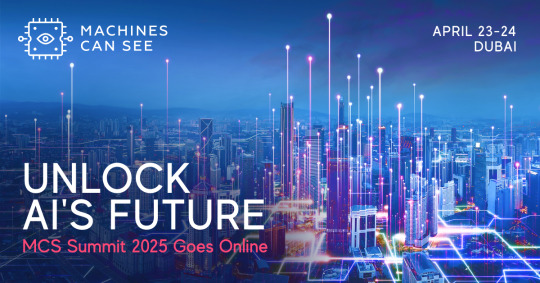#Computer Vision Industry
Explore tagged Tumblr posts
Text
The Evolving Role of AI in the Computer Vision Market
The Computer Vision Market size was valued at USD 12.5 billion in 2023 and is predicted to reach USD 29.3 billion by 2030 with a CAGR of 15.2% from 2024-2030.
Access full report: https://www.nextmsc.com/report/computer-vision-market
0 notes
Text
0 notes
Text
How Computer Vision is Reducing Manufacturing Defects in Home Appliances
Discover how AI-powered computer vision is transforming home appliance manufacturing by automating quality control, defect detection, and predictive maintenance. Learn how leading brands like Whirlpool have reduced defects, improved efficiency, and cut costs with AI-driven manufacturing solutions. Explore how smart manufacturing can enhance production and ensure product reliability. Partner with Theta Technolabs for cutting-edge AI and computer vision solutions to optimize your manufacturing process.
#Computer vision in manufacturing#AI-powered quality control#Artificial Intelligence#Technology#Smart manufacturing with AI#AI in industrial quality control
0 notes
Text
Machine learning applications in semiconductor manufacturing
Machine Learning Applications in Semiconductor Manufacturing: Revolutionizing the Industry
The semiconductor industry is the backbone of modern technology, powering everything from smartphones and computers to autonomous vehicles and IoT devices. As the demand for faster, smaller, and more efficient chips grows, semiconductor manufacturers face increasing challenges in maintaining precision, reducing costs, and improving yields. Enter machine learning (ML)—a transformative technology that is revolutionizing semiconductor manufacturing. By leveraging ML, manufacturers can optimize processes, enhance quality control, and accelerate innovation. In this blog post, we’ll explore the key applications of machine learning in semiconductor manufacturing and how it is shaping the future of the industry.
Predictive Maintenance
Semiconductor manufacturing involves highly complex and expensive equipment, such as lithography machines and etchers. Unplanned downtime due to equipment failure can cost millions of dollars and disrupt production schedules. Machine learning enables predictive maintenance by analyzing sensor data from equipment to predict potential failures before they occur.
How It Works: ML algorithms process real-time data from sensors, such as temperature, vibration, and pressure, to identify patterns indicative of wear and tear. By predicting when a component is likely to fail, manufacturers can schedule maintenance proactively, minimizing downtime.
Impact: Predictive maintenance reduces equipment downtime, extends the lifespan of machinery, and lowers maintenance costs.
Defect Detection and Quality Control
Defects in semiconductor wafers can lead to significant yield losses. Traditional defect detection methods rely on manual inspection or rule-based systems, which are time-consuming and prone to errors. Machine learning, particularly computer vision, is transforming defect detection by automating and enhancing the process.
How It Works: ML models are trained on vast datasets of wafer images to identify defects such as scratches, particles, and pattern irregularities. Deep learning algorithms, such as convolutional neural networks (CNNs), excel at detecting even the smallest defects with high accuracy.
Impact: Automated defect detection improves yield rates, reduces waste, and ensures consistent product quality.
Process Optimization
Semiconductor manufacturing involves hundreds of intricate steps, each requiring precise control of parameters such as temperature, pressure, and chemical concentrations. Machine learning optimizes these processes by identifying the optimal settings for maximum efficiency and yield.
How It Works: ML algorithms analyze historical process data to identify correlations between input parameters and output quality. Techniques like reinforcement learning can dynamically adjust process parameters in real-time to achieve the desired outcomes.
Impact: Process optimization reduces material waste, improves yield, and enhances overall production efficiency.
Yield Prediction and Improvement
Yield—the percentage of functional chips produced from a wafer—is a critical metric in semiconductor manufacturing. Low yields can result from various factors, including process variations, equipment malfunctions, and environmental conditions. Machine learning helps predict and improve yields by analyzing complex datasets.
How It Works: ML models analyze data from multiple sources, including process parameters, equipment performance, and environmental conditions, to predict yield outcomes. By identifying the root causes of yield loss, manufacturers can implement targeted improvements.
Impact: Yield prediction enables proactive interventions, leading to higher productivity and profitability.
Supply Chain Optimization
The semiconductor supply chain is highly complex, involving multiple suppliers, manufacturers, and distributors. Delays or disruptions in the supply chain can have a cascading effect on production schedules. Machine learning optimizes supply chain operations by forecasting demand, managing inventory, and identifying potential bottlenecks.
How It Works: ML algorithms analyze historical sales data, market trends, and external factors (e.g., geopolitical events) to predict demand and optimize inventory levels. Predictive analytics also helps identify risks and mitigate disruptions.
Impact: Supply chain optimization reduces costs, minimizes delays, and ensures timely delivery of materials.
Advanced Process Control (APC)
Advanced Process Control (APC) is critical for maintaining consistency and precision in semiconductor manufacturing. Machine learning enhances APC by enabling real-time monitoring and control of manufacturing processes.
How It Works: ML models analyze real-time data from sensors and equipment to detect deviations from desired process parameters. They can automatically adjust settings to maintain optimal conditions, ensuring consistent product quality.
Impact: APC improves process stability, reduces variability, and enhances overall product quality.
Design Optimization
The design of semiconductor devices is becoming increasingly complex as manufacturers strive to pack more functionality into smaller chips. Machine learning accelerates the design process by optimizing chip layouts and predicting performance outcomes.
How It Works: ML algorithms analyze design data to identify patterns and optimize layouts for performance, power efficiency, and manufacturability. Generative design techniques can even create novel chip architectures that meet specific requirements.
Impact: Design optimization reduces time-to-market, lowers development costs, and enables the creation of more advanced chips.
Fault Diagnosis and Root Cause Analysis
When defects or failures occur, identifying the root cause can be challenging due to the complexity of semiconductor manufacturing processes. Machine learning simplifies fault diagnosis by analyzing vast amounts of data to pinpoint the source of problems.
How It Works: ML models analyze data from multiple stages of the manufacturing process to identify correlations between process parameters and defects. Techniques like decision trees and clustering help isolate the root cause of issues.
Impact: Faster fault diagnosis reduces downtime, improves yield, and enhances process reliability.
Energy Efficiency and Sustainability
Semiconductor manufacturing is energy-intensive, with significant environmental impacts. Machine learning helps reduce energy consumption and improve sustainability by optimizing resource usage.
How It Works: ML algorithms analyze energy consumption data to identify inefficiencies and recommend energy-saving measures. For example, they can optimize the operation of HVAC systems and reduce idle time for equipment.
Impact: Energy optimization lowers operational costs and reduces the environmental footprint of semiconductor manufacturing.
Accelerating Research and Development
The semiconductor industry is driven by continuous innovation, with new materials, processes, and technologies being developed regularly. Machine learning accelerates R&D by analyzing experimental data and predicting outcomes.
How It Works: ML models analyze data from experiments to identify promising materials, processes, or designs. They can also simulate the performance of new technologies, reducing the need for physical prototypes.
Impact: Faster R&D cycles enable manufacturers to bring cutting-edge technologies to market more quickly.
Challenges and Future Directions
While machine learning offers immense potential for semiconductor manufacturing, there are challenges to overcome. These include the need for high-quality data, the complexity of integrating ML into existing workflows, and the shortage of skilled professionals. However, as ML technologies continue to evolve, these challenges are being addressed through advancements in data collection, model interpretability, and workforce training.
Looking ahead, the integration of machine learning with other emerging technologies, such as the Internet of Things (IoT) and digital twins, will further enhance its impact on semiconductor manufacturing. By embracing ML, manufacturers can stay competitive in an increasingly demanding and fast-paced industry.
Conclusion
Machine learning is transforming semiconductor manufacturing by enabling predictive maintenance, defect detection, process optimization, and more. As the industry continues to evolve, ML will play an increasingly critical role in driving innovation, improving efficiency, and ensuring sustainability. By harnessing the power of machine learning, semiconductor manufacturers can overcome challenges, reduce costs, and deliver cutting-edge technologies that power the future.
This blog post provides a comprehensive overview of machine learning applications in semiconductor manufacturing. Let me know if you’d like to expand on any specific section or add more details!
#semiconductor manufacturing#Machine learning in semiconductor manufacturing#AI in semiconductor industry#Predictive maintenance in chip manufacturing#Defect detection in semiconductor wafers#Semiconductor process optimization#Yield prediction in semiconductor manufacturing#Advanced Process Control (APC) in semiconductors#Semiconductor supply chain optimization#Fault diagnosis in chip manufacturing#Energy efficiency in semiconductor production#Deep learning for semiconductor defects#Computer vision in wafer inspection#Reinforcement learning in semiconductor processes#Semiconductor yield improvement using AI#Smart manufacturing in semiconductors#AI-driven semiconductor design#Root cause analysis in chip manufacturing#Sustainable semiconductor manufacturing#IoT in semiconductor production#Digital twins in semiconductor manufacturing
0 notes
Text
Harnessing the Power of Artificial Intelligence for Workplace Safety
🚀 Ready to see how Artificial Intelligence is transforming workplaces? Visionify is at the forefront of innovation with solutions that leverage AI to enhance safety, productivity, and compliance. Our new blog, “AI for Workplace Safety: The Economic Impact,” dives into the role of AI in creating safer industrial environments.
With Camera AI Technology, companies gain real-time monitoring for Workplace Safety, enabling proactive hazard detection and PPE Compliance assessment. These AI for Workplace Safety solutions make managing risks easier and create safer environments for everyone.
See how PPE Detection and other tools from Visionify are supporting compliance while minimizing incidents. Dive into the future of workplace safety with AI-powered tools designed to make workplaces smarter, safer, and more productive!
Know more.: Vision AI, Workplace Compliance Monitoring, safety tips, PPE Compliance, Easy to use EHs software, Workplace Safety AI solution, Machine Learning for Manufacturing, what is compliance in the workplace, Computer Vision Workplace Safety, Workplace safety Software, AI employee monitoring, safety KPI’s, industrial safety, Industrial safety companies, smoke and fire detector, construction monitoring, hazard analysis, accident prevention, health and safety app, Workplace Safety
#Vision AI#Workplace Compliance Monitoring#safety tips#PPE Compliance#Easy to use EHs software#Workplace Safety AI solution#Machine Learning for Manufacturing#what is compliance in the workplace#Computer Vision Workplace Safety#Workplace safety Software#AI employee monitoring#safety KPI’s#industrial safety#Industrial safety companies#smoke and fire detector#construction monitoring#hazard analysis#accident prevention#health and safety app#Workplace Safety
0 notes
Text
What Is the Future of Robotics in Everyday Life?
As technology continues to evolve at a rapid pace, many are asking, what is the future of robotics in everyday life? From automated vacuum cleaners to advanced AI assistants, robotics is steadily becoming an integral part of our daily routines. The blending of artificial intelligence with mechanical engineering is opening doors to possibilities that seemed like science fiction just a decade…
#Agriculture#AI#AI Assistants#AI future#AI healthcare#AI integration#AI Robots#artificial intelligence#automation#autonomous vehicles#Cobots#Collaborative Robots#Computer Vision#Domestic Robots#Drone Delivery#drones#education#environmental monitoring#ethics#everyday life#Exoskeletons#future tech#Future Technology#Healthcare#home automation#home security#Industrial Robots#Industry 4.0#job displacement#machine learning
1 note
·
View note
Text
Machines Can See 2025 – Dubai AI event
New Post has been published on https://thedigitalinsider.com/machines-can-see-2025-dubai-ai-event/
Machines Can See 2025 – Dubai AI event


An AI investment and networking event, Machines Can See, will take place April 23-24 in Dubai at the iconic Museum of the Future, as part of Dubai AI week.
Machines Can See is staged by the Polynome Group, a machine vision, AI, robotic, and industrial design company based in the city.
This is the third year of the event, and will bring investors, business leaders, and policymakers together to explore AI-centric expansion opportunities. Machines Can See, as the name suggests, will have a particular focus on computer vision.
Each discussion and keynote is designed to be firmly rooted in practical applications of AI technology, but organisers hope that the show will be permeated with a sense of discovery and that attendees will be able to explore the possibilities of the tech on show. “We are not just shaping the future of AI, we are defining how AI shapes the world,” said Alexander Khanin, head of the Polynome Group.
UAE Government officials attending the event include H.E. Omar Sultan Al Olama, UAE Minister of State for Artificial Intelligence, Digital Economy, and Remote Work Applications, and H.E. Hamad Obaid Al Mansoori, the Director General of Digital Dubai.
Polynome Group has said that X will be the official streaming partner for Machines Can See 2025, and the US company will host workshops titled “X and AI” to show solutions that merge AI and streaming technologies, with GRok X central to those sessions. Via interactive demos, attendees will gain firsthand experience of GRok’s potential in AI delivery, analysis and optimisation.
Investment and business opportunities
UAE’s AI market is projected to grow by $8.4 billion in the next two years, and the summit is designed to serve as a venue for investors to engage with AI startups, existing enterprises, and government decision-makers. Attendees at Machines Can See will get to meet with investors and venture capital firms, be given the opportunity to meet executives from AI companies (including IBM and Amazon), and connect with startups seeking investment.
The summit is supported by Amazon Prime Video & Studios, Amazon Web Services, Dubai Police, MBZUAI, IBM, SAP, Adia Lab, QuantumBlack and Yango. The involvement of many organisations and large-scale enterprises should provide many opportunities for funding and collaborations that extend the commercial use of AI.
Local and international investors include Eddy Farhat, Executive Director at e& capital, Faris Al Mazrui, Head of Growth Investments at Mubadala, Major General Khalid Nasser Alrazooqi General Director of Artificial Intelligence, Dubai Police UEA, and Dr. Najwa Aaraj, the CEO of TII.
Speakers and insights
The summit will feature several US-based AI professionals, including Namik Hrle, IBM Fellow and Vice President of Development at the IBM Software Group, Michael Bronstein, DeepMind Professor of AI at Oxford University, Marc Pollefeys, Professor of Computer Science at ETH Zurich, Gerard Medioni, VP and Distinguished Scientist at Amazon Prime Video & Studio, and Deva Ramanan, Professor at the Robotics Institute of Carnegie Mellon University.
The event will feature a ministerial session composed of international government representatives to discuss the role of national IT development.
Among speakers already confirmed for the event are Gobind Singh Deo, Malaysia’s Minister of Digital, H.E. Zhaslan Madiyev, Minister of Digital Development, Innovation, and Aerospace Industry of Kazakhstan, and H.E. Omar Sultan Al Olama, UAE Minister of State for Artificial Intelligence, Digital Economy, and Remote Work Applications.
Event organisers expect to announce more representatives from overseas in the coming days. Read more here.
#2025#aerospace#aerospace industry#ai#AI technology#Amazon#amazon prime#Amazon Web Services#amp#Analysis#applications#artificial#Artificial Intelligence#billion#Business#Carnegie Mellon University#CEO#Companies#computer#Computer Science#Computer vision#decision-makers#DeepMind#Design#development#economy#Enterprises#ETH Zurich#event#executives
0 notes
Text
Simplify Art & Design with Leonardo's AI Tools!
Leonardo AI is transforming the creative industry with its cutting-edge platform that enhances workflows through advanced machine learning, natural language processing, and computer vision. Artists and designers can create high-quality images and videos using a dynamic user-friendly interface that offers full creative control.
The platform automates time-consuming tasks, inspiring new creative possibilities while allowing us to experiment with various styles and customized models for precise results. With robust tools like image generation, canvas editing, and universal upscaling, Leonardo AI becomes an essential asset for both beginners and professionals alike.



#LeonardoAI
#DigitalCreativity
#Neturbiz Enterprises - AI Innovations
#Leonardo AI#creative industry#machine learning#natural language processing#computer vision#image generation#canvas editing#universal upscaling#artistic styles#creative control#user-friendly interface#workflow enhancement#automation tools#digital creativity#beginners and professionals#creative possibilities#sophisticated algorithms#high-quality images#video creation#artistic techniques#seamless experience#innovative technology#creative visions#time-saving tools#robust suite#digital artistry#creative empowerment#inspiration exploration#precision results#game changer
1 note
·
View note
Text
Face mask appearance inspection machine, Intsoft Tech machine vision solution
#face mask making machine#integrated machine vision solutions for the smart factory#custom automated mechanical machines#optical inspection#deep learning for vision systems#computer system validation in pharmaceutical industry
1 note
·
View note
Text
PPE Monitoring Solution for Leading Automotive Component Manufacturers

Implementing a PPE monitoring solution for an automotive component manufacturer addresses safety challenges such as unsafe incidents and compliance issues. The solution includes CCTV surveillance for real-time monitoring, integration with SAP and Industry 4.0 for data synchronization, and IoT integration to enhance safety measures. It ensures comprehensive checks for helmets, eyeglasses, shoes, and other PPE, effectively mitigating accidents and promoting workplace safety.
#automotive industry#automotive component manufacturer#ppe monitoring solution#ppe monitoring#computer vision technology#thirdeye ai
0 notes
Text
Empowering Retail Transformation: The Impact of Computer Vision Solutions for Retail

The surge in interest towards computer vision solutions for retail sector is unsurprising, given the substantial data generation and visual feedback requirements inherent in retail operations.
According to Benchmark research, while only 3% of retail companies have adopted computer vision, a significant 40% plan to do so within the next two years.
Employing computer vision solutions for retail services allows retailers to address numerous pain points and enhance both employee and customer experiences. For instance, utilizing real-life data and heat maps for store layout improvements proves more effective than relying solely on intuition.
In today's consumer landscape, brick-and-mortar stores are expected to offer the same level of personalization and convenience as online retailers. This is driving the growing popularity of virtual reality and computer vision in retail. Features like virtual mirrors in fitting rooms elevate offline retail experiences to new levels of personalization. Additionally, self-checkout systems equipped with computer vision cameras streamline operations, while automation of routine tasks frees up time for customer-focused activities.
With the aid of machine learning consulting and an integrative approach to computer vision solutions for retail industry implementation, the digital transformation of retail companies becomes increasingly feasible.
The Rise of Computer Vision Solutions in Retail
Embracing Innovation for Competitive Advantage
The retail industry is witnessing a transformative shift with the integration of computer vision solutions. These advanced technologies utilize machine learning algorithms and real-time imaging to provide invaluable insights into customer behaviour, optimize inventory management, and streamline operations.
Optimizing Inventory Management
Efficiency through Automation
One of the key applications of computer vision solutions in retail industry is optimizing inventory management. By automating tasks such as stock monitoring, product tracking, and shelf replenishment, retailers can ensure accurate inventory counts, reduce stock outs, and improve overall operational efficiency.
Enhancing Customer Experience
Personalization and Convenience
Computer vision solutions enable retailers to offer personalized shopping experiences to customers. Through features like virtual mirrors in fitting rooms and real-time product recommendations based on customer preferences, retailers can enhance engagement and drive sales.
Improving Security and Loss Prevention
Ensuring a Safe Shopping Environment
Another crucial aspect of computer vision solutions in retail is security and loss prevention. By deploying surveillance cameras equipped with computer vision technology, retailers can detect and deter theft, minimize losses, and ensure the safety of both customers and employees.
Conclusion: Embracing the Future of Retail
Driving Growth and Innovation
As technology continues to evolve, computer vision solutions will play an increasingly vital role in shaping the future of retail. By embracing these innovative technologies, retailers can stay ahead of the competition, drive growth, and deliver exceptional customer experiences in the dynamic retail landscape.
0 notes
Text
Role of Computer Vision in Industry 4.0: Top 5 Use Cases Transforming Manufacturing Industry
In the manufacturing sector, the integration of Computer Vision marks a revolutionary leap forward, propelling its use to create a legacy of computer vision for Industry 4.0 into a new era of efficiency, precision, and connectivity. At the heart of this transformation is the ability of computer vision for manufacturing safety to impart machines with visual perception, enabling them to interpret and respond to the visual intricacies of the manufacturing environment.
1 note
·
View note
Text

🗜 𝐈𝐧𝐝𝐮𝐬𝐭𝐫𝐲 4.0 has become increasingly recognized, and 𝐈𝐧𝐝𝐮𝐬𝐭𝐫𝐢𝐚𝐥 𝐈𝐨𝐓 (𝐈𝐈𝐨𝐓) 𝐒𝐨𝐥𝐮𝐭𝐢𝐨𝐧𝐬 are driving the #digitaltransformation in the manufacturer's industries. At the same time, the appearance of developed connectivity technology, such as #5G, allows manufacturers to take the edge of technologies such as industrialization, #artificialintelligence, augmented reality, and the Internet of Things (IoT) to build elegant manufacturers.
⚙ Manufacturing, energy, utilities, and various core industry sectors have initiated to embrace the 𝐈𝐧𝐝𝐮𝐬𝐭𝐫𝐢𝐚𝐥 𝐈𝐧𝐭𝐞𝐫𝐧𝐞𝐭 𝐨𝐟 𝐓𝐡𝐢𝐧𝐠𝐬 (𝐈𝐈𝐨𝐓) vision. Being an #industrialiot 4.0 Solution provider, #kpis allows us to decrease the complexity of developing #iotapplications with its 𝐈𝐧𝐝𝐮𝐬𝐭𝐫𝐢𝐚𝐥 𝐈𝐨𝐓 𝐒𝐨𝐥𝐮𝐭𝐢𝐨𝐧 abilities. Our #IIoT sensor networks deliver real-time data and analytics and offer benefits such as: ↪ Automatic machine maintenance and operations ↪ More efficient inventory planning and optimisation ↪ Decreased carbon footprint via operational efficiencies ↪ Risk ease, quicker identification of implementation issues ↪ Enhanced traceability, visibility, and utilisation of field-deployed support and tools ↪ Improve employee security, reducing unsafe conditions resulting in damage or death
🗜 The #Industry40 revolution would not exist if there weren't any connectivity with automation. Leverage our expertise in developing 𝐈𝐈𝐨𝐓 𝐒𝐨𝐥𝐮𝐭𝐢𝐨𝐧𝐬 to add intelligent capabilities to the manufacturing procedure and connectivity to analogue equipment.
📍 We build 𝐂𝐮𝐬𝐭𝐨𝐦 𝐈𝐧𝐝𝐮𝐬𝐭𝐫𝐢𝐚𝐥 𝐈𝐨𝐓 𝐒𝐨𝐟𝐭𝐰𝐚𝐫𝐞 𝐒𝐨𝐥𝐮𝐭𝐢𝐨𝐧𝐬 to fulfil your business needs. If you are ready to prepare for the next generation and don't want to be left behind by the industry around you, then #krishnapadamitsolution is willing to help you.
🔊𝐂𝐨𝐧𝐭𝐚𝐜𝐭 𝐔𝐬🔊 ➖➖➖➖➖➖➖➖ 🌐 𝐕𝐢𝐬𝐢𝐭: https://www.kpis.in/iot-development 📧 𝐄𝐦𝐚𝐢𝐥: [email protected] 📞 𝐂𝐨𝐧𝐭𝐚𝐜𝐭: +91-6350359218 ➖➖➖➖➖➖➖➖
#internet of things#iot#iiot#industrial iot#industrial internet of things#industry 4.0#aitechology#ai#artificialintelligenceapplication#artificial intelligence#machine learning#bigdata#computer vision#business development#mobile app developer company#mobile application development#app development company#inventory software#software development company#web development company
0 notes
Note
Hi! So I have been seeing your posts talking about AI art and tbh it has made me reconsider my stance that was admittedly very reactionary and I was wondering if you could clarify something you said "the sooner people give up on luddite dead end pursuits of turning back the clock to more indivualized production the sooner they can put their energy into productive working class organizing. " Does this mean as in artists genuinely starting to recognize themselves as part of the working class and forming "collectives" and working as such? Or is it in the sense that art as a career will always inherently be part of the petite bourgeoisie? I hope I worded this correctly I am genuinely interested in hearing your thoughts as it has helped me rethink my stances thank u!! :)
the former! there's nothing about being an artist that automatically makes you petit bourgeoise (even if that is a common aspirational vision, most working artists are straightforwardly proletarian & doing work-for-hire projects, animating trolls 7: return of the trolls or desigining ui elements for FIFA 27--when i say 'productive working class organizing', i mean in their capacity as working artists, i'm not doing some kind of 'get a real job' routine.
for an exmaple of what effective working class organizing can look like for artists, look at the recent SAG-AFTRA agreements. instead of hoping that yelling at people on the computer would make the technology magically go away forever, they levered their industrial action to extract concessions about its use, including requiring the consent of actors to recreate their likeness digitally and requiring actors to be paid for the appearances of that likeness.
similarly, the WAG strike resulted in an agreement under which studios can't edit already written scripts with AI or produce scripts with AI and demand that an uncredited human edit them. these are actual, practical concessions extracted from employers that preserve working conditions and livelihoods. these are good political aims worth fighting for! but as you quote me saying, they are achieved through organized industrial action and not through shouting at twitter users innit
426 notes
·
View notes
Text
Simplify Art & Design with Leonardo's AI Tools!
Leonardo AI is transforming the creative industry with its cutting-edge platform that enhances workflows through advanced machine learning, natural language processing, and computer vision. Artists and designers can create high-quality images and videos using a dynamic user-friendly interface that offers full creative control.
The platform automates time-consuming tasks, inspiring new creative possibilities while allowing us to experiment with various styles and customized models for precise results. With robust tools like image generation, canvas editing, and universal upscaling, Leonardo AI becomes an essential asset for both beginners and professionals alike.
#LeonardoAI
#DigitalCreativity
#Neturbiz Enterprises - AI Innovations


#Leonardo AI#creative industry#machine learning#natural language processing#computer vision#image generation#canvas editing#universal upscaling#artistic styles#creative control#user-friendly interface#workflow enhancement#automation tools#digital creativity#beginners and professionals#creative possibilities#sophisticated algorithms#high-quality images#video creation#artistic techniques#seamless experience#innovative technology#creative visions#time-saving tools#robust suite#digital artistry#creative empowerment#inspiration exploration#precision results#game changer
1 note
·
View note
Text
https://www.metamute.org/editorial/articles/californian-ideology
There is an emerging global orthodoxy concerning the relation between society, technology and politics. We have called this orthodoxy `the Californian Ideology' in honour of the state where it originated. By naturalising and giving a technological proof to a libertarian political philosophy, and therefore foreclosing on alternative futures, the Californian Ideologues are able to assert that social and political debates about the future have now become meaningless. The California Ideology is a mix of cybernetics, free market economics, and counter-culture libertarianism and is promulgated by magazines such as WIRED and MONDO 2000 and preached in the books of Stewart Brand, Kevin Kelly and others. The new faith P has been embraced by computer nerds, slacker students, 30-something capitalists, hip academics, futurist bureaucrats and even the President of the USA himself. As usual, Europeans have not been slow to copy the latest fashion from America. While a recent EU report recommended adopting the Californian free enterprise model to build the 'infobahn', cutting-edge artists and academics have been championing the 'post-human' philosophy developed by the West Coast's Extropian cult. With no obvious opponents, the global dominance of the Californian ideology appears to be complete. On superficial reading, the writings of the Californian ideologists are an amusing cocktail of Bay Area cultural wackiness and in-depth analysis of the latest developments in the hi-tech arts, entertainment and media industries. Their politics appear to be impeccably libertarian - they want information technologies to be used to create a new `Jeffersonian democracy' in cyberspace in its certainties, the Californian ideology offers a fatalistic vision of the natural and inevitable triumph of the hi-tech free market.
from "The Californian Ideology" by Richard Barbrook and Andy Cameron, 1 September 1995
#the californian ideology#mute magazine#Richard Barbrook#Andy Cameron#technological determinism#from 1995 folks
201 notes
·
View notes